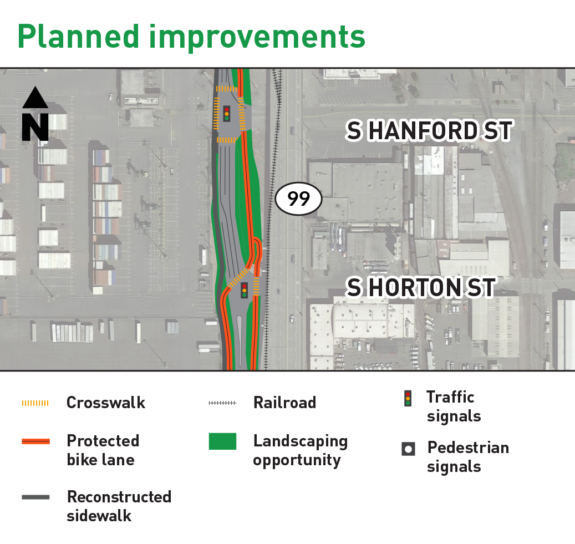
Confusion over the rights to a mostly unused and perhaps even forgotten rail line has delayed work on a major designed and funded remake of East Marginal Way between downtown and the West Seattle bridges. As we reported in April, the contract for construction has been awarded with work scheduled to begin right about now. But due to this rail delay as well as a delay in replacing a water main, work is now expected to start in early 2024 and wrap up in 2026.
The Seattle Times’ David Kroman reported that SDOT has had a difficult time figuring out who even owns an active agreement with the city to use the tracks, which are so overgrown that there are bushes growing in them in places. But federal laws have a lot of protections for preserving rail lines, so the city must get permission from any railroad operators who have active agreements before altering the tracks. The street’s design plan would remove the tracks directly adjacent to the roadway near S Hanford Street and reactivate a set of tracks located closer to and under the elevated SR-99 freeway instead. So the railway path will not be eliminated, but it would be altered enough that permission is required.
However, it has taken years to figure out who even has the rights to the tracks because both BNSF and Union Pacific did not even realize they owned them, Kroman reported:
SDOT staff set about trying to find the owners. For a full year, BNSF said the tracks weren’t theirs, while Union Pacific said the same.
It turned out the tracks were jointly owned by both, as laid out in a more than 100-year-old franchise agreement with the city of Seattle.
The first site visit with the rail companies was in early 2020 — just before everything locked down for COVID-19. The pandemic slowed progress.
Eventually, the rail companies agreed in principle that it would work to tear up the tracks blocking the future bike lane and reactivate some idle ones just to the east. But so far, no agreement has been signed.
The agreement dates back to a time shortly after the city filled in the tideflats to create the industrial district where the tracks sit. The railroads have changed names and consolidated many times since then, making it difficult to establish the ownership paper trail. Nearly all rail activity in the area is concentrated to the east of SR-99, leaving this little rail line on the west side of the highway to grow bushes and rust. Unlike other rail lines in the area, the forgotten west side tracks do not have modern traffic controls.
Do you ride E Marginal Way often? If so, let us know in the comments below if you have ever seen a train on the roadway-adjacent tracks near Hanford.
Project Manager Megan Hoyt stressed to the Times that “no one’s being obstructionist.” As we have seen in the Ballard Missing Link case, for example, railway rights can be a potent tool for obstructing work if that’s what the railroad owners choose to do. In this case, industrial and safe streets advocates are firmly on the same page about this work. Not only will it create a separated and protected bike route through this vital connection to West Seattle and the Duwamish Trail, but it will also enhance access to a series of busy and important Port of Seattle entrances. The Port, the city and the federal government have all contributed funding to this project. Hopefully BNSF and Union Pacific will simply sign the necessary agreements so that work can begin.








Comments
2 responses to “E Marginal Way remake delayed due to old railroad agreement confusion”
I bike this route often, and have never seen a train in this disused yard. It doesn’t have connectivity to the north, so it’s just a stub end rail yard that is overgrown with bushes and thus not usable. Would love to have this be a space for a real bike path to downtown, as the bike lanes on E Marginal are rough, bumpy, flood easily, and are really really close to the large trucks that frequent the corridor.
Trains use that track occasionally at S Hanford, but not often. Here is a photo of one.
https://www.flickr.com/photos/don_brubeck/53283911810/in/photolist-2pbvYAE
This project benefits BNSF and UP directly, by making it safer and more efficient to transfer containers between their rail yards and the port terminals. It’s time for BNSF and UP officials to act like citizens instead of like fuedal lords. Step up and solve this.